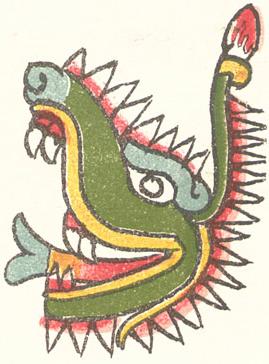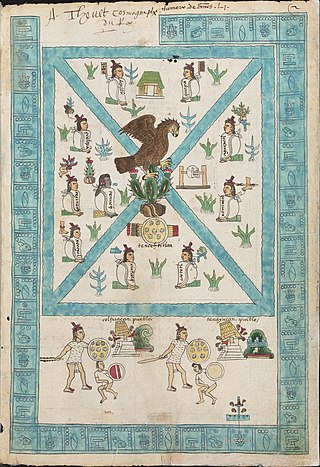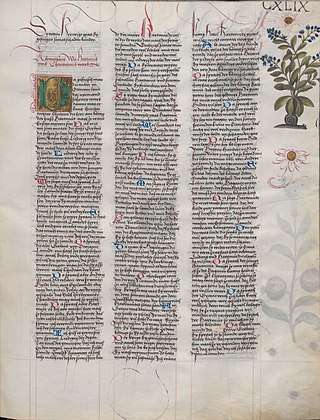
Codex Vindobonensis Mexicanus I, also known as Codex Vindobonensis C, or Codex Mexicanus I is an accordion-folded pre-Columbian piece of Mixtec writing. It is a ritual-calendrical and genealogical document dated to the 14th century.

Codex Vindobonensis Mexicanus I, also known as Codex Vindobonensis C, or Codex Mexicanus I is an accordion-folded pre-Columbian piece of Mixtec writing. It is a ritual-calendrical and genealogical document dated to the 14th century.
Codex Vindobonensis has 52 pages with size 26.5 by 22 cm. It was composed in a form of harmony with length 13.5 m. Its weight is 2.687 kg. The text is divided into 10 major sections. In the beginning it presents mythological genealogies of gods. It also contains lists of Mixtec rulers and priests.
It is not certain where the codex was discovered. It was likely discovered in Veracruz and sent to Sevilla, together with the manuscript Codex Zouche-Nuttall, as a gift for Charles V in 1519. The later story of the codex is not well known, but it traveled to Portugal, Rome, Weimar, and finally Vienna.
The manuscript frequently changed owners and places in which it was housed. As a result, its name was changed 18 times. It was known as Codex Constantinopolitanus, Codex Byzantinus, and Codex Mexicanus I. The last name is more often used in the present day.
It is currently housed at the Austrian National Library at Vienna.

Cipactli was the first day of the Aztec divinatory count of 13 X 20 days and Cipactonal "Sign of Cipactli" was considered to have been the first diviner. In Aztec cosmology, the crocodile symbolized the earth floating in the primeval waters. According to one Aztec tradition, Teocipactli "Divine Crocodile" was the name of a survivor of the flood who rescued himself in a canoe and again repopulated the earth. In the Mixtec Vienna Codex, Crocodile is a day associated with dynastic beginnings.

The Dresden Codex is a Maya book, which was believed to be the oldest surviving book written in the Americas, dating to the 11th or 12th century. However, in September 2018 it was proven that the Maya Codex of Mexico, previously known as the Grolier Codex, is, in fact, older by about a century. The codex was rediscovered in the city of Dresden, Germany, hence the book's present name. It is located in the museum of the Saxon State Library. The codex contains information relating to astronomical and astrological tables, religious references, seasons of the earth, and illness and medicine. It also includes information about conjunctions of planets and moons.

The Austrian National Library is the largest library in Austria, with more than 12 million items in its various collections. The library is located in the Neue Burg Wing of the Hofburg in center of Vienna. Since 2005, some of the collections have been relocated within the Baroque structure of the Palais Mollard-Clary. Founded by the Habsburgs, the library was originally called the Imperial Court Library ; the change to the current name occurred in 1920, following the end of the Habsburg Monarchy and the proclamation of the Austrian Republic. The library complex includes four museums, as well as multiple special collections and archives.

The Codex Zouche-Nuttall or Codex Tonindeye is an accordion-folded pre-Columbian document of Mixtec pictography, now in the collections of the British Museum. It is one of about 16 manuscripts from Mexico that are entirely pre-Columbian in origin. The codex derives its name from Zelia Nuttall, who first published it in 1902, and Baroness Zouche, its donor.

Aztec codices are Mesoamerican manuscripts made by the pre-Columbian Aztec, and their Nahuatl-speaking descendants during the colonial period in Mexico.

The Codex Magliabechiano is a pictorial Aztec codex created during the mid-16th century, in the early Spanish colonial period. It is representative of a set of codices known collectively as the Magliabechiano Group. The Codex Magliabechiano is based on an earlier unknown codex, which is assumed to have been the prototype for the Magliabechiano Group. It is named after Antonio Magliabechi, a 17th-century Italian manuscript collector, and is held in the Biblioteca Nazionale Centrale, Florence, Italy.
Mesoamerica, along with Mesopotamia and China, is one of three known places in the world where writing is thought to have developed independently. Mesoamerican scripts deciphered to date are a combination of logographic and syllabic systems. They are often called hieroglyphs due to the iconic shapes of many of the glyphs, a pattern superficially similar to Egyptian hieroglyphs. Fifteen distinct writing systems have been identified in pre-Columbian Mesoamerica, many from a single inscription. The limits of archaeological dating methods make it difficult to establish which was the earliest and hence the progenitor from which the others developed. The best documented and deciphered Mesoamerican writing system, and the most widely known, is the classic Maya script. Earlier scripts with poorer and varying levels of decipherment include the Olmec hieroglyphs, the Zapotec script, and the Isthmian script, all of which date back to the 1st millennium BC. An extensive Mesoamerican literature has been conserved, partly in indigenous scripts and partly in postconquest transcriptions in the Latin script.

Mixtec writing originated as a logographic writing system during the Post-Classic period in Mesoamerican history. Records of genealogy, historic events, and myths are found in the pre-Columbian Mixtec codices. The arrival of Europeans in 1520 AD caused changes in form, style, and the function of the Mixtec writings. Today these codices and other Mixtec writings are used as a source of ethnographic, linguistic, and historical information for scholars, and help to preserve the identity of the Mixtec people as migration and globalization introduce new cultural influences.

Codex Petropolitanus Purpureus, designated by N or 022, ε 19, is a Greek New Testament codex containing the four Gospels. Using the study of comparative writing styles (palaeography), it has been assigned to the 6th century CE.

The Codex Laud, or Laudianus, is a sixteenth-century Mesoamerican codex named for William Laud, an English archbishop who was the former owner. It is from the Borgia Group, and is a pictorial manuscript consisting of 24 leaves from Central Mexico, dating from before the Spanish takeover. It is evidently incomplete.

The Codex Colombino is a part of a Mixtec codex held in the collection of the National Museum of Anthropology in Mexico City. It is one of only two Mesoamerican codices that remain in Mexican territory. It deals with the genealogy, marriages and bellicose conquests of the Mixtec lord Eight Deer Jaguar Claw.

The Codex Cospi is a pre-Columbian Mesoamerican pictorial manuscript, included in the Borgia Group. It is currently located in the library of the University of Bologna.

The Codex Bodley is an important pictographic manuscript and example of Mixtec historiography. It was named after the colloquial name of the Bodleian Library, where it has been stored since the 17th century.

Codex Vaticanus B, also known as Codex Vaticanus 3773, Codice Vaticano Rituale, and Códice Fábrega, is a pre-Columbian Middle American pictorial manuscript, probably from the Puebla part of the Mixtec region, with a ritual and calendrical content. It is a member of the Borgia Group of manuscripts. It is currently housed at the Vatican Library.
The Department of Manuscripts and Rare Books of the Austrian National Library in Vienna was formed in April 2008 by merging the departments of "Manuscripts, Autographs, and Closed Collections" and of "Incunabula, Old and Valuable Books".
The Codex Vindobonensis 751, also known as the Vienna Boniface Codex, is a ninth-century codex comprising four different manuscripts, the first of which is one of the earliest remaining collections of the correspondence of Saint Boniface. The codex is held in the Austrian National Library in Vienna.

The Codex Selden is a Mexican manuscript of Mixtec origin. The codex is an account of the genealogy of the Jaltepec dynasty from the tenth to the 16th century. Codex Selden is possibly a fragment of a much longer improperly stored document. Although it was completed after the arrival of the conquistadors in the Mixtec region, it is considered one of the six pre-Hispanic Mixtec codices that survived the Spanish conquest of the Aztec Empire. The last date mentioned in the Codex is 1556, which can be interpreted as the date when the codex was finished.

The Selden Roll is a 16th-century Mexican manuscript painted roll from the Coixtlahuaca region, incorporating both Mixtec and Aztec elements, probably recording myths of the origin and migration of divine ancestors.

The Ambraser Heldenbuch is a 16th-century manuscript written in Early New High German, now held in the Austrian National Library. It contains a collection of 25 Middle High German courtly and heroic narratives along with some shorter works, all dating from the 12th and 13th centuries. For many of the texts it is the sole surviving source, which makes the manuscript highly significant for the history of German literature. The manuscript also attests to an enduring taste for the poetry of the MHG classical period among the upper classes.

Mesoamerican codices are manuscripts that present traits of the Mesoamerican indigenous pictoric tradition, either in content, style, or in regards to their symbolic conventions. The unambiguous presence of Mesoamerican writing systems in some of these documents is also an important, but not defining, characteristic, for Mesoamerican codices can comprise pure pictorials, native cartographies with no traces of glyphs on them, or colonial alphabetic texts with indigenous illustrations. Perhaps the best-known examples among such documents are Aztec codices, Maya codices, and Mixtec codices, but other cultures such as the Tlaxcaltec, the Purépecha, the Otomi, the Zapotecs, and the Cuicatecs, are creators of equally relevant manuscripts. The destruction of Mesoamerican civilizations resulted in only about twenty known pre-Columbian codices surviving to modern times.